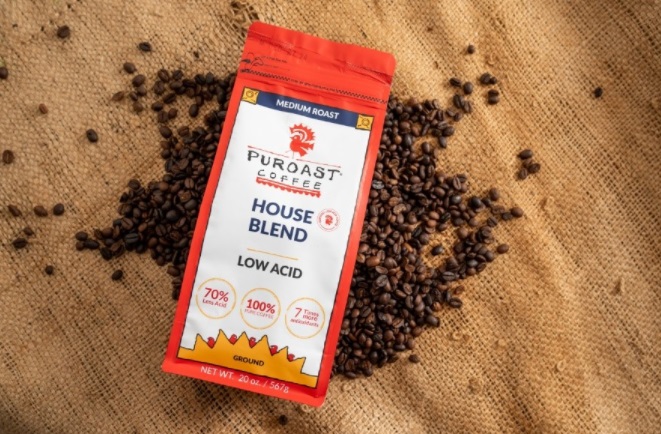
Coffee isn’t just a beverage; it’s a daily ritual for millions around the globe, a must-have for kickstarting the day. Yet, for some, this cherished ritual comes with a side effect – the acidity of regular coffee can cause discomfort. Enter Pure Roast Low Acid Coffee, a game-changer for those sensitive to acidity.
This special coffee blend marries the rich, robust taste of pure roasted coffee with significantly lower acidity levels. It’s designed not just to delight your taste buds but to offer a gentler, healthier coffee experience. By opting for Pure Roast Low Acid Coffee, you invite the joy and warmth of coffee back into your mornings, without the worry of acidity.
Key Takeaways
- Gentle on the Stomach: No more choosing between your love for coffee and your digestive comfort. Pure Roast Low Acid Coffee is crafted to reduce stomach discomfort, making every cup a worry-free delight.
- Rich in Antioxidants: While lowering acidity, these coffees don’t skimp on health benefits. They’re packed with antioxidants, aiding in fighting off free radicals and supporting overall health.
- Smooth Taste: Enjoy the full, rich flavor of coffee without the bitter edge. Low acid coffee offers a smoother, more rounded taste profile that’s easy on the palate.
- Variety of Choices: From the lush volcanic soils of Indonesia to the high elevations of Central America, Pure Roast Low Acid Coffee comes in a variety of single-origin and blended options. Each one promises a unique taste experience while maintaining low acidity.
Understanding Low Acid Coffee
Low acid coffee is exactly what it sounds like: coffee with lower acidity levels than your average brew. This doesn’t just mean it’s easier on your stomach; it means a whole new world of coffee enjoyment for those who might have had to skip their morning cuppa due to acidity issues. So, what’s the deal with low acid coffee, and how do they make it less acidic? There are mainly two ways: treatment and natural processes.
Treated Low Acid Coffee: Some beans undergo special treatments to reduce their acidity. This might involve techniques like slow roasting, steaming the beans before roasting, or even specific roasting methods designed to minimize acid content without compromising on flavor.
Naturally Low-Acid Coffee Beans: Then there’s coffee that’s naturally low in acid. These beans typically come from certain regions where the conditions—like altitude, soil type, and climate—naturally result in a bean that’s lower in acidity. Think coffee from Sumatra, Brazil, or Peru.
Benefits of Low Acid Coffee
For many, the switch to low acid coffee is nothing short of a revelation. The most immediate benefit? A significant reduction in stomach discomfort, acid reflux, and other digestive issues often associated with high-acid coffees. But the perks don’t stop there.
Low acid coffee is gentle on the digestive system, making it a fantastic choice for those who experience heartburn or GERD. Plus, it still packs a punch in terms of antioxidants, offering all the health benefits of regular coffee without the acidity.
Worried about missing out on taste? Don’t be. Low acid coffee retains the rich, complex flavors that coffee lovers seek. From smooth, chocolatey notes to bright, fruity undertones, reducing acidity doesn’t mean sacrificing taste.
How Pure Roast Low Acid Coffee is Made
Creating pure roast low acid coffee involves a meticulous process from bean to brew, leveraging nature and technique to produce a gentler cup. Here’s how it’s done:
Wet Hulling: This method is often used in regions like Indonesia. After picking, the coffee cherries are partially dried, then hulled in a semi-wet state. This unique process not only contributes to the coffee’s distinct flavor profile but also naturally reduces the bean’s acidity. The moisture level during hulling affects the acidity, making it a crucial step for ensuring the coffee is easier on the stomach.
Shade Growing: Coffee plants that grow under a canopy of trees, rather than in direct sunlight, tend to produce beans that are naturally lower in acid. The shade slows down the growth of the coffee cherries, allowing them to mature at a leisurely pace. This prolonged growth period lets the beans develop a more complex sugar structure, which translates to less acidity and a richer flavor in your cup.
Volcanic Soil: Beans grown in volcanic soil, such as those from regions around Mount Kilimanjaro or the Indonesian archipelago, benefit from the rich, mineral-dense earth. This soil composition not only supports the growth of coffee plants but also contributes to the production of beans that are lower in acid. The unique combination of minerals in the soil impacts the overall flavor profile and acidity level of the coffee, offering a smooth, stomach-friendly brew.
Popular Low Acid Coffee Brands
Puroast: This brand takes pride in offering coffee that’s not only low in acid but also high in antioxidants—about seven times more than green tea, in fact. Their unique roasting process, which they term “Lost Art,” focuses on quality over quantity, ensuring each bean is roasted to perfection without direct heat. This method results in coffee that’s 70% less acidic than standard roasts, offering a smooth taste that’s gentle on the stomach.
Volcanica Coffee’s Komodo Dragon Coffee: Sourced from the exotic islands of Indonesia, Komodo Dragon Coffee is a testament to Volcanica’s dedication to unique, flavorful, and low-acid coffee options. Grown in volcanic soil, this coffee is naturally lower in acid due to the rich, mineral-dense earth it’s cultivated in. It features a distinctive flavor profile with floral notes and hints of cocoa, making it a rich and aromatic choice for coffee enthusiasts.
Lifeboost Coffee: Lifeboost prioritizes health and flavor by offering a selection of organic, non-GMO, and low-acid coffee. Their beans are shade-grown at high elevations, which naturally reduces the acidity level. The attention to detail extends to handpicking and sun-drying, ensuring the final product is of the highest quality. Lifeboost’s coffee is not just easy on the stomach but also on the palate, with a smooth flavor profile featuring chocolate and caramel notes.
Brewing the Perfect Cup of Pure Roast Low Acid Coffee
When it comes to brewing low acid coffee, the goal is to extract the best flavors without increasing acidity. Here are some tips to achieve that perfect cup:
- Choose the Right Roast and Grind Size: Medium to dark roasts are typically lower in acid, and a coarse grind is ideal for reducing extraction, which can increase acidity. This combination is particularly effective for cold brewing, which inherently produces coffee with less acidity.
- Cold Brew Techniques: Cold brewing is an excellent method for making low acid coffee even smoother. By steeping coffee grounds in cold or room-temperature water for 12 to 24 hours, you create a brew that’s naturally sweeter and less bitter. This method doesn’t extract as much acidity from the beans, making it a perfect match for low acid coffee.
- Adjust Your Brewing Method: While cold brew is a standout option, other brewing methods can also suit low acid coffee well. Using a French press or pour-over can allow you to control the brewing time and temperature, which helps in avoiding over-extraction that leads to higher acidity.
FAQs
What are the health benefits of low acid coffee?
Low acid coffee is known for being gentler on the stomach and digestive system. It’s a great choice for coffee lovers who experience acid reflux or other gastrointestinal discomforts from regular coffee. Additionally, it retains the antioxidants found in coffee, which are beneficial for overall health.
How does low acid coffee compare to regular coffee?
Taste-wise, low acid coffee can be just as rich and flavorful as regular coffee, offering a smooth experience without the bitterness that high acidity can bring. In terms of health, it’s easier on the digestive system, making it a better choice for those sensitive to acidity.
Any tips for making my coffee less acidic?
Certainly! Opting for a dark roast can help, as they’re typically lower in acid. Cold brewing is another effective method to reduce acidity, as it extracts fewer acids from the beans. Finally, adding a dash of milk or a milk alternative can also neutralize some of the coffee’s acidity.
Final Thoughts
Pure Roast Low Acid Coffee stands out as a stellar choice for those seeking a milder, stomach-friendly coffee option without sacrificing the deep, rich flavors that make coffee such a beloved beverage. By embracing the unique processing techniques like wet hulling, shade growing, and the cultivation in volcanic soil, these coffees offer a smoother, more pleasant drinking experience.
Whether you’re someone who deals with digestive discomfort from traditional coffee or simply looking to explore new coffee horizons, low acid coffee presents a compelling, healthier alternative that doesn’t skimp on taste.









